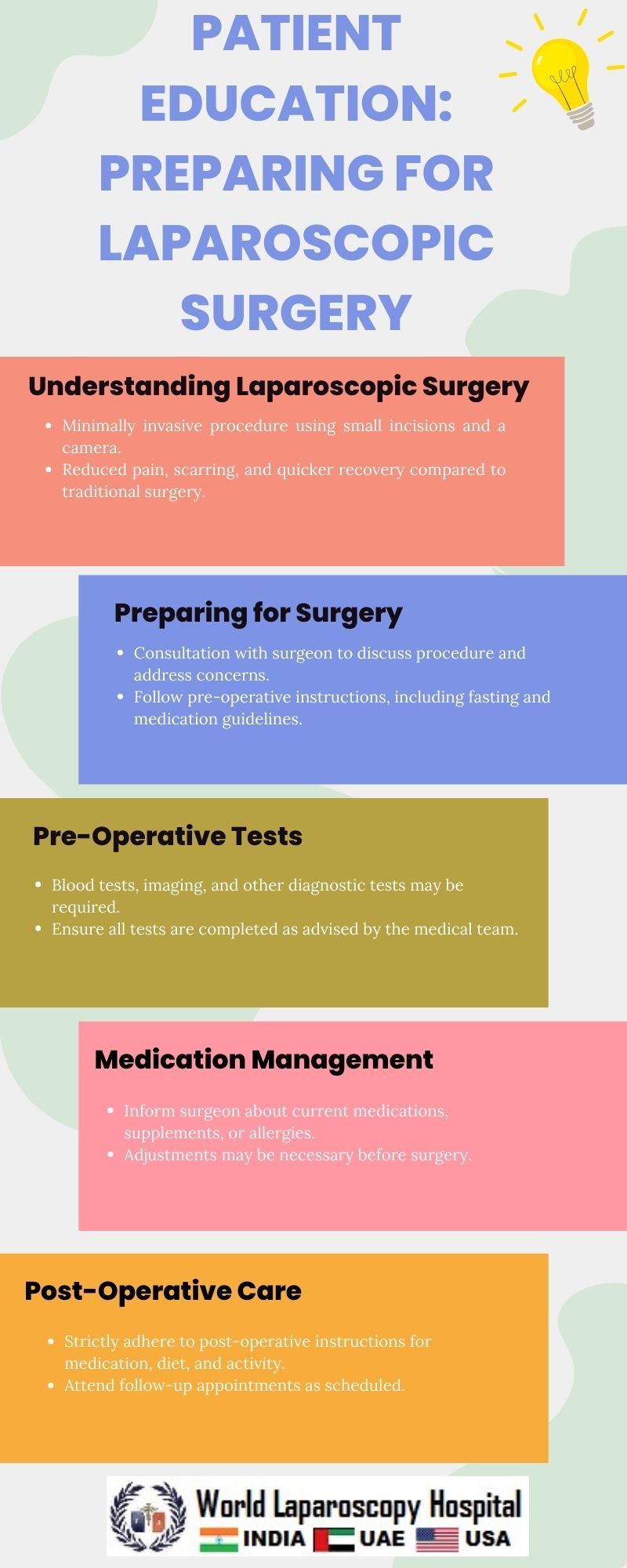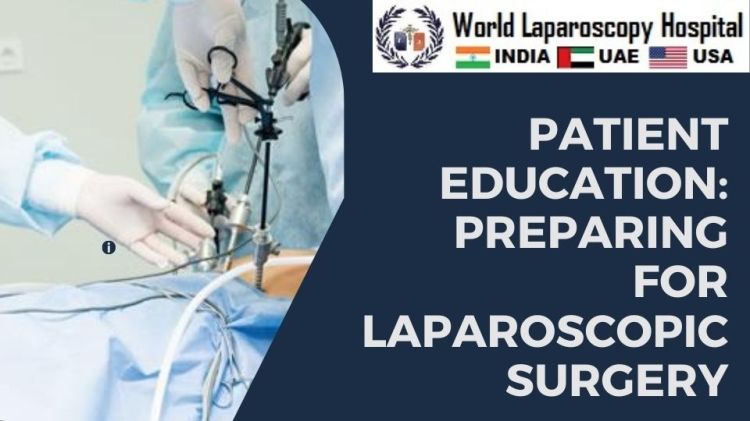Patient Education: Preparing for Laparoscopic Surgery
Introduction
Laparoscopic surgery, also known as minimally invasive surgery, has revolutionized the field of surgical procedures by offering a less invasive alternative to traditional open surgeries. This technique involves making small incisions through which a camera and specialized instruments are inserted, allowing surgeons to perform intricate procedures with minimal disruption to surrounding tissues. As a patient gearing up for laparoscopic surgery, understanding the process, preparing adequately, and being aware of what to expect postoperatively are crucial aspects of ensuring a successful outcome. In this comprehensive guide, we'll delve into the intricacies of laparoscopic surgery, covering everything from preoperative preparations to postoperative care.

Understanding Laparoscopic Surgery
Overview of Laparoscopic SurgeryTo comprehend the significance of laparoscopic surgery, it's essential to grasp the fundamental principles of this innovative approach. Unlike traditional open surgeries that require large incisions, laparoscopic surgery involves small keyhole incisions, reducing trauma to the body. A tiny camera, called a laparoscope, provides real-time visuals of the surgical site, while specialized instruments allow the surgeon to perform intricate procedures with precision.
Advantages and DisadvantagesAdvantages
Laparoscopic surgery offers several advantages over traditional open surgery, such as shorter recovery times, reduced postoperative pain, and smaller scars. Patients generally experience less blood loss, a lower risk of infection, and a quicker return to normal activities.
Disadvantages
While laparoscopic surgery has numerous benefits, it's essential to acknowledge potential disadvantages, such as the need for specialized training for surgeons, longer operating times for certain procedures, and the possibility of complications related to the insufflation of gas into the abdominal cavity.
Preoperative Preparations
Patient Education
Understanding the Procedure
A crucial aspect of preparing for laparoscopic surgery is gaining a comprehensive understanding of the procedure itself. Patients should be well-informed about the specific surgery they will undergo, including the reasons for the procedure, expected outcomes, and potential risks.
Benefits and Risks
An open and honest discussion with the healthcare team is essential. Patients should be aware of the benefits and risks associated with laparoscopic surgery, allowing them to make informed decisions about their treatment. Common benefits include quicker recovery and reduced scarring, while potential risks may involve bleeding, infection, or injury to surrounding organs.
Preoperative Assessments
Medical History
Thorough preoperative assessments involve a review of the patient's medical history. Any pre-existing conditions, medications, allergies, or previous surgeries must be communicated to the healthcare team to ensure a comprehensive understanding of the patient's overall health.
Diagnostic Tests
Depending on the nature of the surgery, various diagnostic tests may be required, such as blood tests, imaging studies, or electrocardiograms. These tests help assess the patient's overall health and identify any potential complications that may affect the surgical process.
Lifestyle ModificationsDiet and Fasting
In the days leading up to laparoscopic surgery, patients may be instructed to modify their diet and fasting routines. Clear guidelines on when to stop eating and drinking help reduce the risk of complications during the procedure, such as aspiration.
Smoking Cessation and Alcohol
Patients who smoke are often advised to quit or at least reduce smoking before surgery, as smoking can impede the healing process. Similarly, alcohol consumption may need to be limited, as it can interact with anesthesia and medications.
Medication Management
Prescription Medications
Patients should communicate all prescription medications to their healthcare team. Depending on the medications, adjustments may be necessary before surgery. Blood-thinning medications, for instance, may need to be temporarily discontinued to reduce the risk of excessive bleeding during the procedure.
Over-the-Counter Medications
Even seemingly harmless over-the-counter medications and supplements can impact surgery. Patients should disclose the use of any such substances to their healthcare provider, who can advise on whether any modifications are necessary.
Mental and Emotional PreparationAnxiety and Stress Management
The period leading up to surgery can be emotionally challenging for patients. Implementing stress-reducing techniques, such as mindfulness, meditation, or counseling, can be beneficial in managing anxiety. Open communication with healthcare providers about fears and concerns is encouraged.
Support System
Having a strong support system in place, comprising family, friends, and healthcare professionals, can significantly contribute to a patient's mental and emotional well-being. Knowing there is a network of support can alleviate anxiety and foster a positive outlook.
Day of Surgery
Preoperative InstructionsArrival Time
Patients are typically provided with specific instructions regarding when to arrive at the hospital or surgical center. Adhering to these guidelines ensures a smooth check-in process and allows the healthcare team to maintain a well-organized schedule.
Preoperative Checklist
On the day of surgery, patients may undergo a preoperative checklist, including verification of identification, confirmation of the planned procedure, and discussions about allergies and medications. This process ensures that everyone involved is on the same page before the surgery commences.
AnesthesiaAnesthesia Options
Laparoscopic surgery is typically performed under general anesthesia, which induces a temporary loss of consciousness. An anesthesiologist will discuss the anesthesia plan with the patient, addressing any concerns and explaining the process.
Preoperative Sedation
In some cases, patients may receive preoperative sedation to help alleviate anxiety before being taken to the operating room. This can be administered orally or intravenously, depending on the patient's needs and the surgeon's preference.
Operating Room ExperienceOperating Room Setup
Upon entering the operating room, patients may notice a team of surgical professionals and various equipment. The surgical team will guide the patient onto the operating table, where monitoring devices will be attached to track vital signs throughout the procedure.
Induction of Anesthesia
Once in the operating room, the anesthesiologist will administer anesthesia to induce a state of unconsciousness. Patients will be closely monitored throughout the procedure to ensure their safety and well-being.
Intraoperative Phase
Insufflation and Trocar Placement
Carbon Dioxide Insufflation
Before the laparoscope is inserted, the abdominal cavity is inflated with carbon dioxide gas. This creates a space for the surgeon to maneuver instruments and provides a clear view of the internal organs. The gas is later released at the end of the procedure.
Trocar Placement
Trocars are specialized instruments that serve as entry points for other surgical instruments. Their placement is a critical step in laparoscopic surgery, and the surgeon carefully selects strategic locations for optimal access to the surgical site.
Laparoscopic Instruments
Types of Instruments
Laparoscopic instruments vary based on the nature of the surgery. Common instruments include graspers, scissors, and electrocautery devices. The surgeon manipulates these instruments through the small incisions, guided by the visuals provided by the laparoscope.
Hand-Eye Coordination
Performing laparoscopic surgery requires a high level of hand-eye coordination. Surgeons watch a video monitor displaying the laparoscope's feed while simultaneously manipulating instruments within the patient's body. This skill is honed through specialized training and practice.
Completion of the Procedure
Closing Incisions
Once the surgical procedure is complete, the surgeon carefully closes the small incisions using sutures, staples, or adhesive strips. The choice of closure method depends on various factors, including the type of surgery and the surgeon's preference.
Removal of Trocars and Release of Gas
Trocars are removed, and any residual carbon dioxide gas is released from the abdominal cavity. The small incisions are then covered with sterile dressings, and the patient is transferred to the recovery area.
Postoperative Care
Recovery Room Experience
Monitoring Vital Signs
In the recovery room, patients are closely monitored as they emerge from anesthesia. Vital signs, such as heart rate, blood pressure, and oxygen saturation, are continuously assessed to ensure a smooth transition from the operating room to the recovery area.
Pain Management
Patients may experience varying degrees of postoperative pain, depending on the nature of the surgery. The healthcare team will provide pain management strategies, which may include medications, regional anesthesia techniques, or non-pharmacological interventions.
Resuming Oral IntakeGradual Introduction of Liquids and Solid Foods
The resumption of oral intake is a gradual process. Initially, patients may be allowed to sip clear liquids, progressing to a more regular diet as tolerated. This step is crucial to prevent postoperative complications such as nausea and vomiting.
Ambulation and Physical Activity
Early ambulation, or getting out of bed and moving around, is encouraged as soon as feasible after laparoscopic surgery. This helps prevent complications such as blood clots and aids in the overall recovery process.
Discharge Planning
Criteria for Discharge
Before leaving the hospital or surgical center, patients must meet specific criteria, including stable vital signs, the ability to tolerate oral intake, and effective pain management. The healthcare team will provide clear instructions on postoperative care and follow-up appointments.
Home Recovery Guidelines
Upon discharge, patients receive guidelines for home recovery, including wound care instructions, medication management, and when to seek medical attention for any concerning symptoms. Following these guidelines is crucial for a smooth recovery process.
Potential Complications and Follow-Up
Recognizing Complications
Common Complications
While laparoscopic surgery is generally safe, complications can occur. Patients should be aware of signs of potential issues, such as infection, bleeding, or adverse reactions to anesthesia. Prompt recognition and reporting of symptoms are essential for timely intervention.
Follow-Up Appointments
Scheduled follow-up appointments with the surgeon are vital for monitoring recovery progress and addressing any concerns. These appointments also provide an opportunity to discuss the results of the surgery and any additional steps or recommendations for ongoing care.
Long-Term ConsiderationsPhysical Activity and Lifestyle
As patients recover, they may gradually resume normal physical activities, as advised by their healthcare team. The timeline for returning to specific activities will vary based on the type of surgery and individual factors.
Emotional Well-being
The emotional impact of surgery should not be overlooked. Patients may experience a range of emotions, including relief, anxiety, or even postoperative depression. Open communication with healthcare providers, as well as support from friends and family, plays a crucial role in addressing these emotional aspects of recovery.
Conclusion
In conclusion, preparing for laparoscopic surgery involves a multifaceted approach that encompasses understanding the procedure, thorough preoperative preparations, active participation in the day of surgery, and diligent adherence to postoperative care guidelines. By actively engaging in their healthcare journey, patients can contribute to a positive surgical experience and optimize their chances of a successful recovery. The collaboration between patients and healthcare providers is instrumental in navigating the intricate landscape of laparoscopic surgery, ensuring not only a smooth surgical procedure but also a holistic approach to overall well-being.
